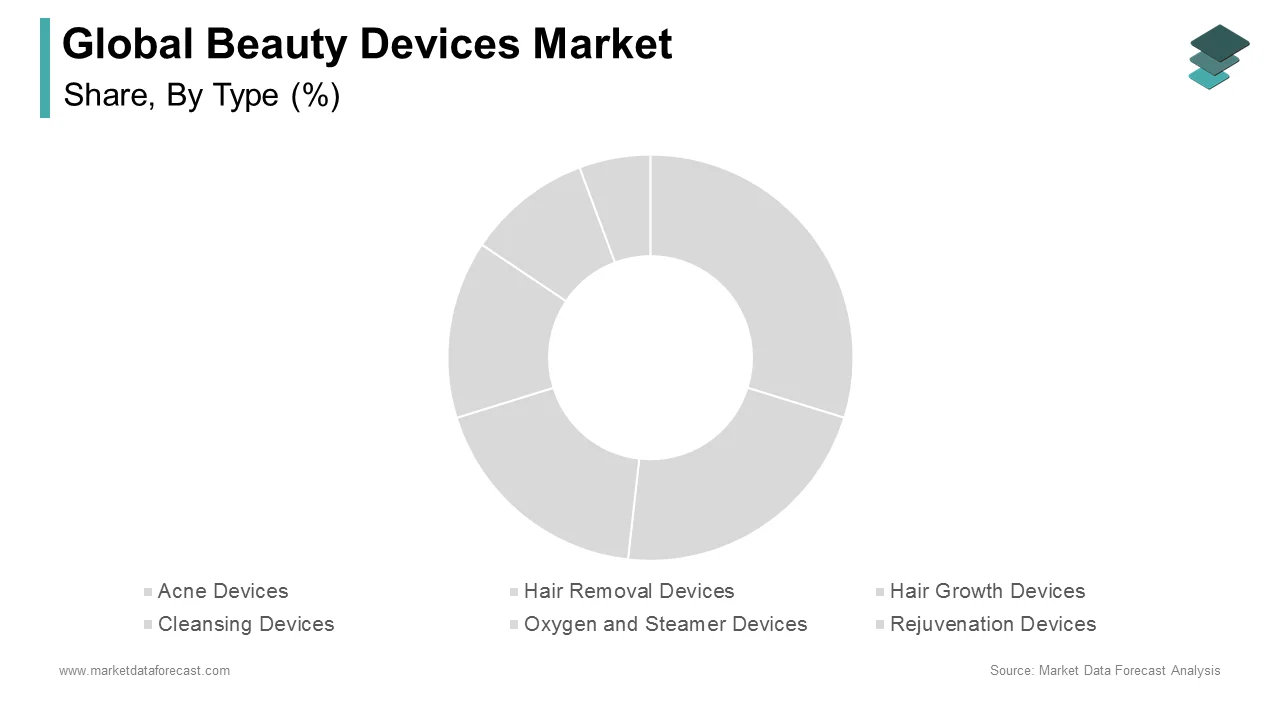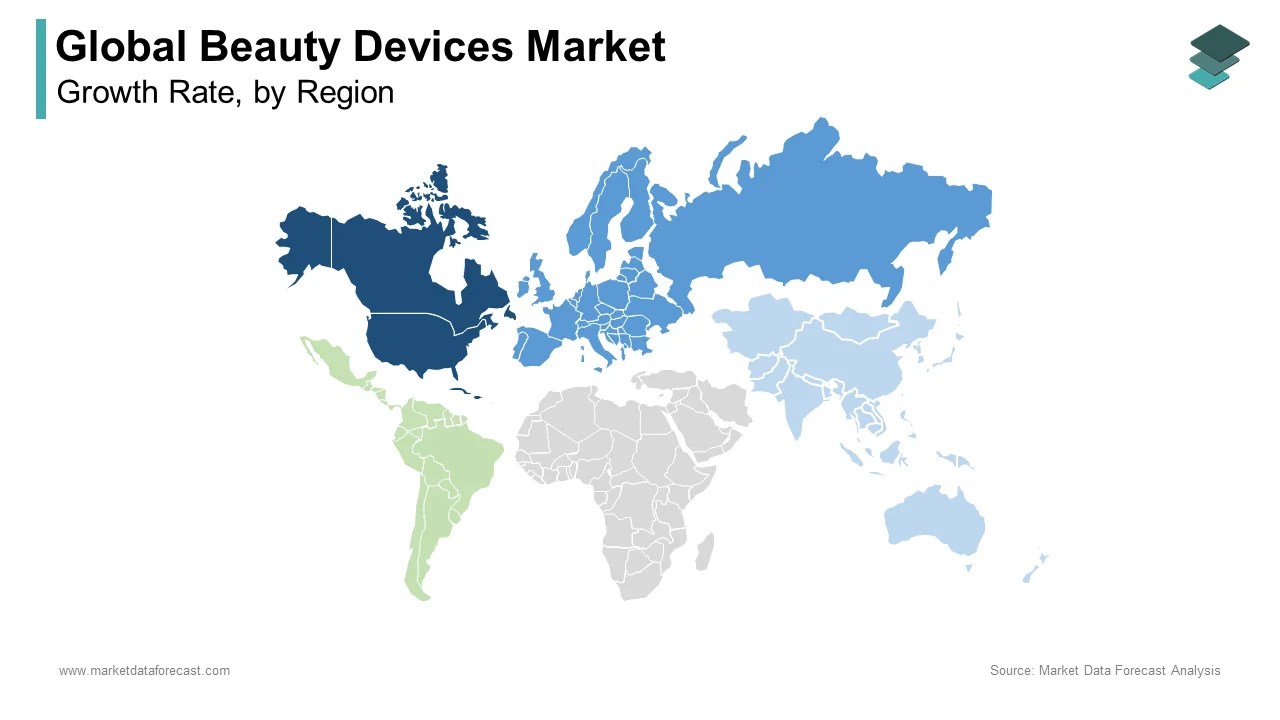Global Beauty Devices Market Size, Share, Trends & Growth Forecast Report By Product Type, Application and Region (North America, Europe, Asia-Pacific, Latin America, Middle East and Africa), Industry Analysis From 2025 To 2033.
Global Beauty Devices Market Size
The size of the global beauty devices market was worth USD 66.7 billion in 2024. The global market is anticipated to grow at a CAGR of 20.2% from 2025 to 2033 and be worth USD 349 billion by 2033 from USD 80.07 billion in 2025.

Beauty devices are products that help to improve a person's physical appearance. These devices aid in the treatment of skin and hair problems. These beauty devices have pledged to deliver the same level of service as any cosmetic procedure. Compared to conventional surgical beauty procedures, energy-based beauty devices offer little skin invasion, quick recovery, fewer side effects, and minor discomfort. Furthermore, these technologies are low-cost, painless, and quick to produce results. These devices are easy to use and carry about. They are very efficient in treating dermal problems. Beauty is one of the essential characteristics of both women and men. Hair, facial, skin, oral, and eye beauty devices are used to treat various conditions relating to appearance. Haircare devices, facial devices, skincare devices, dental care devices, and eye care devices are among the many cosmetic devices available on the market. Light/LED and photo rejuvenation therapy devices are beauty systems that use non-thermal, narrow-band LED light energy to activate the body's natural cell processes. Environmental pollution, tobacco usage, excessive alcohol consumption, and UV radiation are other causes of skin problems.
MARKET DRIVERS
One of the key drivers driving the global beauty devices market is growing awareness of energy-based cosmetic devices' safety profile and benefits, particularly laser-based devices. Fine lines, wrinkles, and skin laxity can all be reduced using laser skin tightening, approved by the Food and Drug Administration (FDA). Increasing appearance consciousness, rising awareness of beauty devices, rising prevalence of skin diseases, growing elderly population, increasing disposable income, and rising incidence of hormonal disorders are a few other primary drivers accelerating the market expansion. According to recent advancements, existing players in the beauty device industry are focusing more on innovative ways and technologically advanced items. In addition, the increased prevalence of skin and hair disorders, such as photoaging of hair and skin, boosts the market need for beauty devices. Dermatologists, doctors, and aestheticians are increasingly using new and innovative beauty products to cure skin problems, improve skin texture, and minimize various indications of aging. Beauty device manufacturers constantly invent new products in response to the growing demand for advanced skincare and haircare solutions.
MARKET RESTRAINTS
The presence of reasonable substitutes and adverse effects from beauty devices may restrict the expansion of the global beauty devices market. The market expansion of beauty devices is hampered by various side effects like scarring, postoperative erythema, ecchymosis, superficial burns, and edema. In addition, the high cost of beauty devices and panels is expected to limit their use and slow the growth of the beauty devices market during the forecast period.Some hazards associated with photo rejuvenation devices, such as soreness, bruising, excessive swelling, fragile skin, and blistering, are significant challenges for the global beauty devices market's growth.
REPORT COVERAGE
|
REPORT METRIC |
DETAILS |
|
Market Size Available |
2024 to 2033 |
|
Base Year |
2024 |
|
Forecast Period |
2025 to 2033 |
|
Segments Covered |
By Type, Application & Region |
|
Various Analyses Covered |
Global, Regional & Country Level Analysis, Segment-Level Analysis, DROC, PESTLE Analysis, Porter’s Five Forces Analysis, Competitive Landscape, Analyst Overview on Investment Opportunities |
|
Regions Covered |
North America, Europe, Asia Pacific, Latin America, Middle East & Africa |
|
Market Leader Profiled |
Nu Skin Enterprises, Panasonic Corporation, Syneron Medical Ltd, Home Skinovations Ltd, TRIA Beauty Inc., |
SEGMENTAL ANALYSIS
By Type Insights

Hair Removal Devices, among other segments, had the most significant share in the global beauty devices market in 2024. The highest percentage of hair removal equipment is due to the rising number of hormonal imbalance cases, notably the worldwide prevalence of polycystic ovary syndrome (PCOS), the most common hormonal disorder among women that promotes facial hair development. In addition, the availability of a variety of hair removal devices, such as trimmers, clippers, epilators, and shavers, gives consumers a wide range of choices and is indicative of the device's highest market share.
By Application Insights
Based on the application, the vast size of the market is attributed to a rise in the number of salons and spas worldwide. Its immense size is also likely to be aided by rising disposable income in emerging nations and increased awareness of beauty treatments. During the forecast period, the at-home segment of beauty devices is predicted to see the quickest growth in demand. The vast availability of goods with simple user interfaces is gaining appeal among customers who support at-home facilities.
REGIONAL ANALYSIS

North America is leading the beauty devices market, followed by Europe and Asia-Pacific. This is primarily due to the region's high disposable income, which encourages consumers to spend more on personal care products. Furthermore, increased consumer awareness of their looks contributes to an increase in the use of technologically enhanced beauty devices. Moreover, the United States continues to dominate based on the number of advanced cosmetics companies. More than 62 percent of overall industry players analyzed are present in this country, while Europe also has a considerable presence of companies in this field, i.e., over 22 percent, and among those regional countries, the United Kingdom is at the top of the list with around 6 percent. Furthermore, customers' perception of beauty items is increasingly inclined towards the value of money rather than solely on cost.
In Europe, the beauty devices market is steadily progressing forward. The continent’s industry development is attributed to dynamic categories, advancing consumer tastes, and transitioning into digital platforms. Also, the luxury beauty sector experienced a significant rise in sales in France and Germany. Apart from this, about 31 percent of the investors in advanced cosmetics are also in Europe after North America. Now, subscription services and online beauty e-commerce platforms are seeing more inflow of investment, and stakeholders are especially focusing on natural (organic) items. However, it receives the highest amount of funding, close to 7.8 billion dollars or over 57 percent of the industry as compared to others. Both Bayer and Evonik Industries are some of the major investors in the area.
The Asia Pacific, beauty devices market, is witnessing an upward growth trend in the fashion and personal care segment and is expected to propel forward during the forecast period. China, South Korea, and Japan are leading the regional industry growth, with India rapidly emerging as the most attractive market due to its comparatively younger population and rising disposable income. Besides this, cosmetics sales have surged since 2021, and in 2024, the purchases surpassed the pre-pandemic levels. This rise shows that lockdowns and health risks have increased the demand quickly. Interestingly, over 50 percent of beauty purchasers in the APAC follow the latest technology trends, news, and updates. A noticeable number of customers owning a VR headset is above 10 percent and coupled with the use of TikTok effects; the market is growing rapidly.
Latin America is anticipated to drive forward at a considerable pace in the coming years. It is believed to earn a revenue exceeding 45 billion dollars. Brazil and Mexico are the two dominant marketplaces. The consumption of natural and organic beauty goods is growing in Brazil because of rising customer awareness of environmentally friendly and sustainable options. Moreover, Mexico is the second-largest regional industry and imports personal care and cosmetic items worth around 1.4 billion dollars from the United States. Traditional sales channels are still very prevalent, but online applications are also swiftly rising.
Middle East and Africa are predicted to have a significant portion of the beauty devices market share. The ME countries are known for their luxury lifestyle and beauty device sales, which are expected to reach 47 billion dollars. In addition, the shifting trend towards skincare among younger people, growing distribution channels and greater purchasing power.
KEY MARKET PLAYERS
L'Oreal S.A., Nu Skin Enterprises, Panasonic Corporation, Syneron Medical Ltd, Home Skinovations Ltd, TRIA Beauty Inc., Procter & Gamble Co, and PhotoMedex Inc. are a few of the noteworthy companies operating in the global beauty devices market profiled in this report.
RECENT MARKET DEVELOPMENTS
-
Nu Skin Enterprises Inc. introduced the ageLOC Boost device in January 2021, which combines microcurrent waveforms with variable pulse technology to produce significantly brighter, plumper, and bouncier skin.
-
Shiseido Cosmetics announced plans to form a joint venture with YA-MAN Ltd. to develop and produce anti-aging devices in Japan in August 2020.
- Potomac Equity Partners announced the acquisition of Laser MD Medspa in July 2020. Laser MD Medspa is a hair removal service provider. Laser MD Medspa's economic prospects and brand recognition are likely to improve due to this acquisition.
MARKET SEGMENTATION
This research report on the global beauty devices market has been segmented and sub-segmented based on type, application & region.
By Type
- Acne Devices
- Hair Removal Devices
- Hair Growth Devices
- Cleansing Devices
- Oxygen and Steamer Devices
- Rejuvenation Devices
- Others
By Application
- Salon & Spa
- Home
- Others
By Region
- North America
- Asia Pacific
- Europe
- Latin America
- The Middle East and Africa
Related Reports
Access the study in MULTIPLE FORMATS
Purchase options starting from
$ 2500
Didn’t find what you’re looking for?
TALK TO OUR ANALYST TEAM
Need something within your budget?
NO WORRIES! WE GOT YOU COVERED!
Call us on: +1 888 702 9696 (U.S Toll Free)
Write to us: sales@marketdataforecast.com
